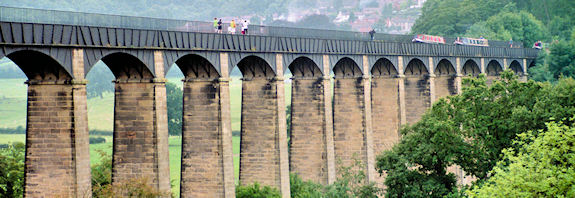
The longest and highest aqueduct in Britain.
Trevor, Denbighshire
The Ellesmere Canal was a canal in England and Wales, originally planned to link the Rivers Mersey, Dee, and Severn, by running from Netherpool (now known as Ellesmere Port) to Shrewsbury. The canal that was eventually constructed was very different from what was originally intended. Part of the Ellesmere Canal has now become known as the Llangollen Canal, part forms a section of the Montgomery Canal, and part forms a section of what is now called the Shropshire Union Canal main line.
The Pontcysyllte Aqueduct is a navigable aqueduct that carries the Llangollen Canal over the valley of the River Dee, between the villages of Trevor and Froncysyllte, Wrexham in north east Wales. Completed in 1805, it is the longest and highest aqueduct in Britain, and is a Grade I Listed Building.
Built by Thomas Telford and William Jessop, it is 307 m. (1,007 ft.) long, 3.4 m. (11 ft.) wide and 1.6 m. (5.25 ft.) deep. It consists of a cast iron trough supported 38 m. (126 ft.) above the river by nineteen hollow masonry piers (pillars). Each span is 16 m. (53 ft.) wide. Many people were sceptical, but Telford was confident: he had built at least one previous cast iron trough aqueduct (the Longden-on-Tern aqueduct on the Shrewsbury Canal, still visible in the middle of a field, though the canal was abandoned years ago).
The mortar used comprised lime, water and ox blood. The iron castings were produced at the Plaskynaston Foundry, and each casting dovetails into the next. To caulk the joints, Welsh flannel was dipped in boiling sugar, after which the joints were sealed with lead. Then it was left for six months with water inside to check it was watertight.
Part of what was originally called the Ellesmere Canal, it was one of the first major feats of civil engineering undertaken by leading civil engineer Thomas Telford (supervised by the more experienced canal engineer William Jessop). The iron was supplied by William Hazledine from his foundries at Shrewsbury and nearby Cefn Mawr. It was opened on 26 November 1805, having taken around ten years to design and build at a total cost of £47,000.
The towpath is cantilevered from the side of the trough, which is the full width of the aqueduct. This arrangement allows the trough to be the maximum width and thus the displaced water from ahead of the boat can more easily flow past the boat, ensuring that narrowboats are able to move as freely as possible through the water. Walkers are protected by railings on the outside edge of the towpath, but the holes to fit railings on the other side of the aqueduct were never used. As the edge of the trough is only about 15 cm (6 inches) above the water level, and therefore below the deck of a narrowboat, the helmsman has nothing between him and the sheer drop.
The embankment to the south is itself one of the largest canal earthworks ever constructed. Three original over-bridges, to the north and south of the aqueduct, are important examples of the composite use of cast-iron and masonry, having shallow segmental masonry arches supported by curved cast-iron ribs. To the north of the aqueduct lies Trevor Basin, where the navigable water feeder from Llangollen meets the terminus of the main line of the Ellesmere Canal as completed. The terminal basin contains a wharf for primitive railways from adjacent coal mines and the Plas Kynaston Ironworks.
This Grade I Listed Building and Wesh National Monument was declared a World Heritage Site in 2009.
By road: Off A5, B5434 Station Road, east of Llangollen.

Arnold, Harry, Montgomery Canal, The History Press, ISBN-10: 075241660X (2003)
Burton, Anthony, Thomas Telford, Aurum Press, ISBN-10: 185410652X (2000)
Douglas, Amy & Collins, Fiona, Memories of Pontcysyllte (2006)
Hadfield, Charles, Thomas Telford's Temptation: Telford and William Jessop's Reputation, M.& M.Baldwin, ISBN-10: 0947712194 (1993)
Hadfield, Charles & Skempton, Alec, William Jessop, Engineer, M.& M.Baldwin, ISBN-10: 0715376039 (1979)
Hughes, Stephen Roy, Archaeology of the Montgomeryshire Canal: Guide To, and Study In, Waterways Archaeology, Royal Commission on the Ancient & Historical Monuments of Wales, ISBN-10: 1871184002 (1988)
Jarvis, Adrian, Ellesmere Port: Canal Town, Avon-Anglia Publications, ISBN-10: 090546608X (1977)
O'Brien, Pat, Ellesmere Port, NPI Media Group, ISBN-10: 075243005X (2003)
Pellow, Thomas & Bowen, Paul, Canal to Llangollen: A Portrait of the Waterway, Landscape Press, ISBN-10: 0947849017 (1987)
Rolt, L. T. C., Thomas Telford, The History Press, ISBN-10: 0750945761 (2007)
Wilson, Edward, Ellesmere and Llangollen Canal, Phillimore & Co, ISBN-10: 0850331099 (1975)
Canal Junction - Llangollen Canal
Canal Junction - Shropshire Union Canal
Shropshire Union Canal Society
UNESCO World Heritage List - Pontcysyllte Aqueduct and Canal